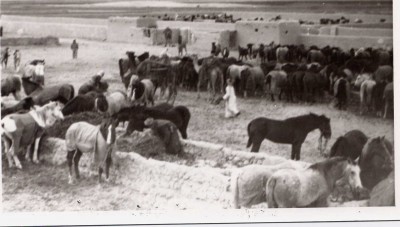Rare image of the Saudi Royal Stud of al-Kharj in the 1960s
This is a unique photo, and a precious witness to an era now long gone. It shows the stables of King Abd al-‘Aziz Aal Saud in the 1960s, at a time when hundreds, if not thousands, of desert-bred horses were being gathered by will or by force, from the Bedouin tribes of Saudi Arabia and beyond (mainly Syria), in the hands of the Saud family. The photo was taken by the late Laura Cavedo, who was being given a tour of the royal studs, and is from the collection of the late William Sheets (Billy). I have fifteen others.
There are surviving first-hand accounts of how Farhan al-‘Ulayyan, one of the most trusted slaves of Miqhim ibn Mhayd, who was the leader of the Fad’aan Bedouins during much of the first half of the XXth century, organized the collecting and the shipping of hundreds of ‘Anazah’s desert-bred horses from Syria to Saudi Arabia, in batches of ten, during the 1960s and 1970s and well up to the 1980s. Farhan would buy all the horses he could find, coaxing the impoverished ‘Anazah (but also Shammar) Bedouins out of their horses, and send them to the stables of the Saud family. He would use intimidation when owners did not part with their mares.
The stud of Dr. Iskandar Qassis in Aleppo, in Aleppo, became known as a last refuge for ‘Anazah Bedouins who did not want to see their horses gone to Farhan, and who would lease their mares or sell them in shares to Qassis. In the early 1980s, the late Qatari consul in Damascus Yusuf al-Rumaihi, who was a true passionate and connoisseur of the real desert-bred Arabian horse, caught the tail end of the exodus of the Syrian desert-bred horses to Saudi Arabia, and was able to persuade Farhan to part with two or three older mares.

I had no idea that this had happened, what a loss for Syria, what happened to the mares,were they bred on from and are their progeny in Saudi today?
Yes, I wonder if they were simply allowed to live out their days as it were, or were they systematically inventoried, evaluated, and used to build a base of well conformed, mentally reliable, athletis national her of horses. This could have served to become the basis for saving the breed. Given that at least so far as we know that didn’t happen it appears that there isn’t much left of them. Perhaps Pureman could let us know what became of them.
Best wishes
Bruce Peek
Did Farhan-Al-‘Ulayyan made the differenciation between pure and non arabian horses, he get by sheer force from bedouins?
He knew where the best horses were. He was reported by both Hammami (the old horse dealer from Aleppo) and Rumaihi (the consul of Qatar) to have been very discerning in his knowledge of horses.
Bruce, most of them were given away to retenue, as gifts, etc, and some of them found their way in the Saudi registry (e.g., the Kuhaylan Abu Janub horses were were talking about some time ago).
That’s interesting.
There is plenty of 19th century reading that the first Saudi state was already the prime reason of the decline of Arabian horses in Nejd because the Wahaby chief either used whatever excuse to confiscate a good mare they wanted, either a man owning a mare was continually forced to go in battle, so many mares were sold.
I already read somewhere that after his conquest Ibn Saud confiscated mares to stop the bedouin raiding in his lands but I believed that was settled in 1930 when he destroyed the Ikhwan?
Why did he still gather horses in the 60ties to 80ties? And as far as Syria? Did the Anazeh raid Nejd until then?
Or did he want to preserve the horses from the severe drought in Syria from ’58 to ’61? I know I read somewhere that this drought effectively ended the bedouin way of life in Syria killing all lifestock.
Wasn’t there a residue of mistrust expressed by the owners of some of the desert bred horses when the Syrian horses were being inventoried by the Syrian Registry officials a few years ago? Basically that the horses who were ostensibly being listed for the stud book would end up being ,”confiscated,” by government authorities. One cannot help but wonder if the bedouins didn’t suspect the motives of the stud book guys given their earlier bad treatment at the hands of the Saudi agents.
Best wishes
Bruce Peek
I think that there was a lot of mistrust, and that some noble people worked very hard to overcome that to save as many horses as they could. Edouard will no doubt write more about that, from a more first-hand perspective!
Hello Edouard,
Still curious why Saud collected in the ’60-’70-’80ties such numbers outside Saudi borders. Was it to save the best horses from the draught or did he fear they would still be used for raids?
the short answer is power, control and politics.
I am the daughter of Laura W. Cavedo. Please send a private message so that we can discuss the picture above. Thank you.
Hi I am working on a new museum project in KSA and would like to use this image in the Museum. I was wondering if you could help me at all? Is there someone who I can contact about reproducing this or any of the other images mentioned? WHo would now hold the copyright?
Hello, Thomas. Kendall Cavedo Maynard would still be the appropriate person to contact. I’m sending you her email privately.